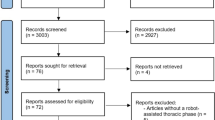Abstract
Radiation-induced afferent loop obstruction is a rare complication following pancreaticoduodenectomy and adjuvant radiotherapy. As in the setting of Roux-en-Y reconstruction endoscopic approaches are limited, surgery of this complication becomes inevitable. This study provides a new classification/management system of the radiation-induced obstruction of the afferent loop based on the extent and location of radiation injury, and describes the Pancreaticojejuno-jejunostomy, a novel technique to avoid revision of the pancreatic anastomosis during reconstruction of the afferent loop. Data were analyzed from nine patients who developed radiation-induced afferent loop obstruction after pancreaticoduodenectomy with single Roux limb reconstruction. One patient had type I obstruction and treated with by-pass surgery, seven patients had type II obstruction and treated with reconstruction including revision of the hepaticojejunostomy and Pancreaticojejuno-jejunostomy, and one patient had type III obstruction and treated with reconstruction including revision of the hepaticojejunostomy and the pancreatic anastomosis. Reconstruction along with Pancreaticojejuno-jejunostomy performed in six patients with type II radiation-induced afferent loop obstruction; reconstruction was not feasible for one patient. The median operative time was 149 min. No intraoperative complication was observed. By performing Pancreaticojejuno-jejunostomy we managed efficiently to convert a pancreatic anastomosis to an enteric anastomosis as one case of Grade B pancreatic fistula and no case of Pancreaticojejuno-jejunostomy stricture were observed, regarding short- and long-term results, respectively. The above technique may have a useful application in the surgical management of the radiation-induced afferent loop obstruction when endoscopy fails and by-pass surgery is inappropriate.






Similar content being viewed by others
References
Pannala R, Brandabur JJ, Gan SI et al (2011) Afferent limb syndrome and delayed GI problems after pancreaticoduodenectomy for pancreatic cancer: single-center, 14-year experience. Gastrointest Endosc 74:295–302
Mönkemüller K, Fry LC, Bellutti M, Neumann H, Malfertheiner P (2009) ERCP with the double balloon enteroscope in patients with Roux-en-Y anastomosis. Surg Endosc 23:1961–1967
Chevallier P, Novellas S, Motamedi JP, Gugenheim J, Brunner P, Bruneton JN (2006) Percutaneous jejunostomy and stent placement for treatment of malignant Roux-en-Y obstruction: a case report. Clin Imaging 30:283–286
Adams DB (2009) The pancreatic anastomosis: the danger of a leak, which anastomotic technique is better? J Gastrointest Surg 13:1182–1183
Yekebas EF, Wolfram L, Cataldegirmen G et al (2007) Postpancreatectomy hemorrhage: diagnosis and treatment: an analysis in 1669 consecutive pancreatic resections. Ann Surg 246:269–280
Slieker JC, Daams F, Mulder IM, Jeekel J, Lange JF (2013) Systematic review of the technique of colorectal anastomosis. JAMA Surg 148:190–201
Bassi C, Dervenis C, Butturini G et al (2005) Postoperative pancreatic fistula: an International Study Group (ISGPF) definition. Surgery 138:8–13
Wente MN, Veit JA, Bassi C et al (2007) Postpancreatectomy hemorrhage (PPH): an International Study Group of Pancreatic Surgery (ISGPS) definition. Surgery 142:20–25
Koch M, Garden OJ, Padbury R et al (2011) Bile leakage after hepatobiliary and pancreatic surgery: a definition and grading of severity by the International Study Group of Liver Surgery. Surgery 149:680–688
Dindo D, Demartines N, Clavien PA (2004) Classification of surgical complications: a new proposal with evaluation in a cohort of 6336 patients and results of a survey. Ann Surg 240:205–213
De Martino C, Caiazzo P, Albano M et al (2012) Acute afferent loop obstruction treated by endoscopic decompression: case report and review of literature. Ann Ital Chir 83:555–558
Smith C, Sarr M, vanHeerden J (1992) Completion pancreatectomy following pancreaticoduodenectomy: clinical experience. World J Surg 16:521–524
Reddy JR, Saxena R, Singh RK et al (2012) Reoperation following pancreaticoduodenectomy. Int J Surg Oncol. doi:10.1155/2012/218248
Demirjian AN, Kent TS, Callery MP, Vollmer CM (2010) The inconsistent nature of symptomatic pancreatico-jejunostomy anastomotic strictures. HPB 12:482–487
Conflict of interest
The authors declare that they have no conflict of interest.
Author information
Authors and Affiliations
Corresponding author
Rights and permissions
About this article
Cite this article
Blouhos, K., Boulas, K.A., Tsiomita, E. et al. Pancreaticojejuno-jejunostomy during reconstruction of the afferent loop in surgery of radiation-induced afferent loop obstruction following pancreaticoduodenectomy with Roux-en-Y reconstruction. Updates Surg 66, 51–57 (2014). https://doi.org/10.1007/s13304-013-0238-8
Received:
Accepted:
Published:
Issue Date:
DOI: https://doi.org/10.1007/s13304-013-0238-8



